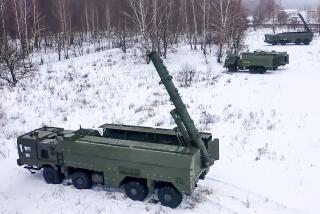Veterans Recall Huge Nuclear Arsenal of 1950s : Defense: Jeep-mounted atomic cannons were overseen by lieutenants and considered just another weapon.
- Share via
WASHINGTON — America’s atomic ambition reached a peak in the 1950s, a time when military leaders believed nuclear arms were just another battlefield tool. No military crisis seemed beyond a nuclear solution.
“We had nuclear weapons that could be fired from a Jeep, that were in the hands of lieutenants,” Gen. John Galvin recalls, with a hint of incredulity in his voice.
Galvin, who is about to oversee the removal of the Army’s nuclear weapons in Europe, was a young lieutenant then. He was talking about the Davy Crockett, a sort of nuclear bazooka for infantrymen in Europe that was perhaps the epitome of a Cold War attitude among U.S. military leaders who saw nuclear arms as “just another weapon.”
Today, the notion of having thousands of nuclear weapons on the battlefield seems unsettlingly absurd. But in the mid and late 1950s, it was doctrine and triggered big changes in the shape and tactics of the Army.
The nuclear infatuation gave birth in 1953 to the “Pentomic” division, a combat unit whose name referred both to its readiness to fight on an atomic battlefield and its breakdown into sets of five “battle groups,” five companies and five platoons.
It was a time when U.S. military and political leaders believed that a nuclear bomb could be as useful in close combat as it was in strategic bombing.
“For blasting a hole in an enemy defense through which mobile forces could roll, nothing could be better,” a 1961 official Army publication states. “Yes, the Army found it could live with nuclear weapons. It could also fight with them.”
That meant putting nuclear warheads on artillery shells, in land mines, on anti-aircraft missiles, on surface-to-surface rockets and even on the 150-pound Davy Crockett guns that could be fired from a Jeep to a range of 1 1/4 miles.
“The sky was the limit,” says Robert S. Norris, a leading expert on U.S. and Soviet nuclear weapons.
Indeed, in the late 1950s the Army studied the possibility of putting the Davy Crockett on a proposed “flying Jeep,” a hybrid vehicle that could race across land and then fold up its wheels and scoot through the air at low altitudes. The flying Jeep concept was dropped but the Davy Crockett was deployed on regular Jeeps in 1961.
Nor were weapons the limit of the Army’s atomic infatuation. It wanted to develop nuclear reactors that would be carted around by truck, airplane or even sled to supply electricity to field hospitals, command centers and radar installations. Another idea was nuclear-powered supply trucks. None came to fruition.
Norris, of the Natural Resources Defense Council, an environmental group, estimates the number of U.S. tactical nuclear weapons in Europe peaked in the early 1970s at 7,100, including nuclear gravity bombs carried on U.S. and allied aircraft.
Most of those weapons were at least as powerful as the Little Boy atomic bomb dropped on Hiroshima in 1945. Little Boy had a yield of about 12 kilotons, or the equivalent of 12,000 tons of TNT.
By the late 1970s, the Army began trimming its tactical nuclear arsenal in Europe as political leaders began seeing the weapons as more a liability than an advantage. But as recently as the mid-1980s the Army still had nuclear land mines there and it was pressing to modernize its nuclear-tipped missiles and artillery.
At a NATO meeting in October in Sicily, allied defense ministers endorsed President Bush’s Sept. 27 initiative to withdraw all 1,300 nuclear artillery shells from Europe and all 700 warheads for Lance surface-to-surface missiles. And they agreed to cut in half the number of nuclear gravity bombs, meaning the only remaining nuclear weapons there will be 700 Air Force gravity bombs.
Galvin, now the commander in chief of all U.S. and NATO forces in Europe, recalls the Davy Crockett gun as an illustration of the Army’s conviction in the early stages of the Cold War that a nuclear weapon was “just another weapon.”
“We’d run around the battlefield with this and we even had serious classes in which you measured the wind direction and you drew little fallout diagrams and you were prepared to fire this weapon,” Galvin said in a recent interview.
The first battlefield nuclear weapon deployed to Europe was a mammoth 280mm (16-inch) artillery gun that was so cumbersome and impractical that it was “absurdly obsolete as soon as it arrived in the field” in 1953, the author A. J. Bacevich wrote in his book, “The Pentomic Era,” about the Army’s atomic heyday.
The gun weighed 83 tons--more than today’s M1-A1 tank--and could not be moved by air. Two tractors were needed to move the cannon on its carriage; one pushing, one pulling.
To show that U.S. soldiers could fight on a nuclear battlefield, the Army conducted a series of exercises in the U.S. desert. The best known of these was Operation Desert Rock VI at Yucca Flat, Nev., in 1955, in which troops of Task Force Razor were in foxholes two miles from ground zero of a nuclear explosion.
Eight minutes after the 30-kiloton blast, the troops advanced in an armored column, coming within 900 yards of ground zero even as a mushroom cloud billowed 40,000 feet above the desert floor, according to Bacevich’s book.
A 1961 Army report titled “Progress” said the Desert Rock exercises convinced soldiers that nuclear weapons “were not quite so awesome as they had suspected. Powerful? Yes. Destructive? Yes. But the ultimate weapon? Certainly not.
“They placed this weapon in its proper perspective and decided they could both defend themselves against it and employ it to advantage.”
More to Read
Sign up for Essential California
The most important California stories and recommendations in your inbox every morning.
You may occasionally receive promotional content from the Los Angeles Times.










